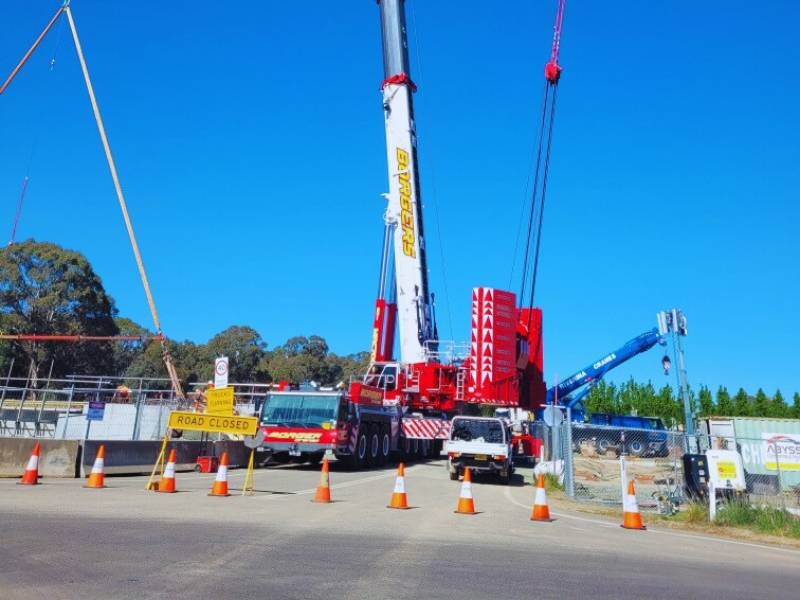Traffic control is vital to ensuring the safe and smooth execution of infrastructure projects, particularly those that involve complex construction efforts like the Wallendbeen Bridge project. This bridge, part of the Burley Griffin Way over the rail corridor, has been under construction, with significant developments scheduled for September 2024. The project illustrates how proper traffic management is necessary for both worker and public safety, and how it aids in keeping large-scale projects on track.
What Is the Wallendbeen Bridge Project?
The Wallendbeen Bridge is an ongoing infrastructure project led by Transport for NSW to build a permanent road-over-rail bridge that will replace the existing temporary bridge. Set on Burley Griffin Way, the new structure will improve road safety and allow the area to accommodate the growing needs of both local commuters and freight traffic.
The bridge is being constructed with several modern elements, including prestressed concrete ‘Super-T’ girders, which are designed to form a robust superstructure. Once complete, the Wallendbeen Bridge will feature a wider, stronger deck, crash barriers, and vertical safety screens.
Why Traffic Control Matters in This Project
Safety First for Workers and the Public: With large-scale machinery like the 650-tonne crane required to lift the girders, traffic control ensures that both workers and the general public remain safe. Lane closures, speed limits, and detours are carefully managed by traffic controllers to minimise risks during construction.
Managing Traffic Flow: As work ramps up, road closures are inevitable. In the Wallendbeen project, Morrisons Hill Road and Silo Road will see temporary closures. Traffic control teams play a crucial role in rerouting local traffic and minimising disruptions while the bridge construction progresses.
24-Hour Operations: With a major part of the work taking place during rail possession weekends, the construction teams will be working around the clock. Efficient traffic control becomes more important than ever, as crews and equipment operate 24/7 to make the most of the time when trains are not running.
Challenges and Solutions in Traffic Management
For a project like the Wallendbeen Bridge, traffic control teams face a variety of challenges, such as dealing with large equipment like cranes, navigating narrow roads, and coordinating road closures with the needs of the local community. A careful balance must be struck between maintaining access for residents and allowing the construction team to operate efficiently.
To manage these challenges, traffic controllers use advanced planning and real-time traffic updates to coordinate road closures, establish detours, and enforce speed reductions, keeping safety at the forefront.
The Role of a Traffic Management Plan (TMP)
A Traffic Management Plan is a key document that outlines the safety protocols and traffic diversion routes during construction. For the Wallendbeen Bridge project, the TMP includes detailed instructions for the positioning of signs, road closures, and temporary speed limits. It also highlights the need for continuous communication between the traffic control team and construction crew to ensure adjustments are made as needed.
TMA Drivers: Critical for Safety
For projects like the Wallendbeen Bridge, Truck-Mounted Attenuators (TMA) are critical. These vehicles are positioned behind roadwork sites and act as a barrier to protect workers from oncoming traffic. TMA drivers are a specialised part of the traffic control team, and their role is indispensable for high-risk operations, particularly when large machinery like cranes are in use.
Managing Community Impact
Infrastructure projects can cause inconvenience to local communities, but proper traffic control minimises these impacts. For example, detours via Allbutts Lane have been established for the Wallendbeen Bridge project, while local traffic is restricted to specific areas to reduce congestion.
Noise and other environmental impacts are also managed through careful planning. Noise levels during the super possession weekend will be monitored, with mitigation measures in place to ensure minimal disruption to residents.
How ECTC Supports Large Infrastructure Projects
East Coast Traffic Control (ECTC) has a strong presence in infrastructure projects across Queensland and New South Wales, providing comprehensive traffic management solutions that prioritise safety and efficiency. For large-scale operations like the Wallendbeen Bridge project, ECTC offers:
Skilled traffic controllers trained to manage complex road and rail intersections
TMA drivers and vehicles to protect work zones
24/7 operational flexibility to accommodate around-the-clock work schedules
Next Steps for Wallendbeen Bridge
Following the successful installation of the Super-T girders, the next phase of the Wallendbeen Bridge project will focus on building the bridge deck, installing crash barriers, and completing the approach slabs. The construction timeline has been extended due to unforeseen ground conditions, but the team remains committed to opening the new bridge to traffic as quickly as possible.
Final Word: Traffic Control’s Essential Role in Infrastructure Development
Traffic control is a critical component of any major infrastructure project, as seen with the ongoing construction of the Wallendbeen Bridge. It not only ensures the safety of workers and the public but also keeps the project running smoothly by managing road closures and rerouting traffic. With projects like this on the rise, the demand for skilled traffic controllers will continue to grow, making it an excellent career choice for those looking to contribute to Australia’s infrastructure development.
FAQs:
What is the Wallendbeen Bridge Project?
The Wallendbeen Bridge project is a major infrastructure initiative aimed at constructing a permanent road-over-rail bridge on Burley Griffin Way.
Why is traffic control necessary for this project?
Traffic control ensures the safety of both workers and the public by managing road closures, detours, and speed limits during construction.
What is a TMA driver, and why are they important?
A TMA (Truck-Mounted Attenuator) driver operates a specialised vehicle designed to protect work zones from oncoming traffic. Their role is critical for high-risk operations involving large machinery.
How are road closures managed during construction?
Traffic control teams plan and execute detours and closures in advance, communicating these changes through signage and real-time traffic updates.
What happens after the Super-T girders are installed?
The next phase of the project involves building the bridge deck, approach slabs, and installing crash barriers, with the aim of completing the bridge as soon as possible.





